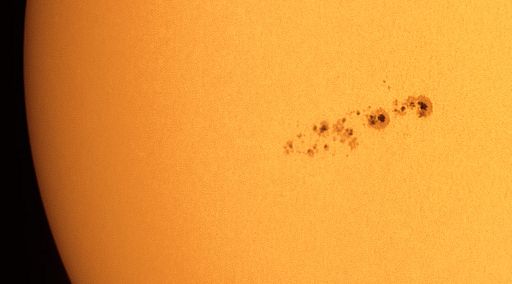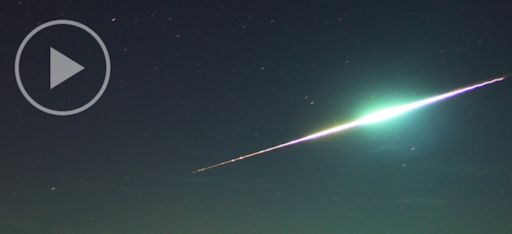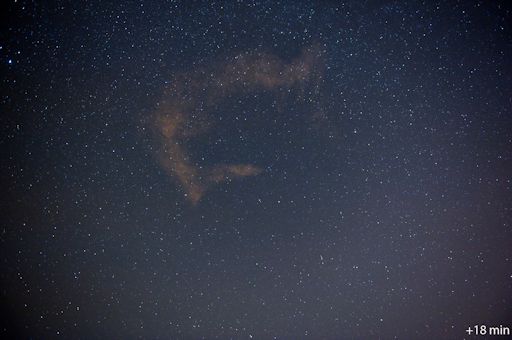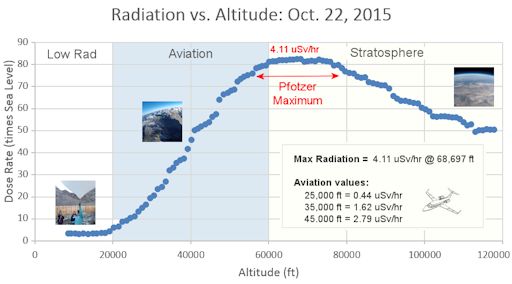Marianne's Heaven On Earth Aurora Chaser Tours Chasethelighttours.co.uk invites you to join them in their quest to find and photograph the Aurora Borealis. Experience the winter wonderland in the Tromsø Area. | | | GEOMAGNETIC STORMS LIKELY TODAY: NOAA forecasters estimate a 90% chance of geomagnetic storms on Nov. 2nd-3rd when a fast-moving stream of solar wind is expected to hit Earth's magnetic field. Solar wind speeds could exceed 800 km/s and spark a strong G3-class geomagnetic storm. Sky watchers in the USA should be alert for Northern Lights as far south as, e.g., Oregon and Illinois. Aurora alerts: text or voice GIANT SUNSPOT HIDES SPACESHIP: Sunspot AR2443 is so big, it is attracting the attention of astrophotographers around the world. Earlier today when Peter Rosén of Stockholm, Sweden, photographed the sprawling complex, he found a spaceship hiding among its dark cores. Seriously. Take a close look at the image below: 
Can't find the spaceship? Click here and here. "It is the International Space Station," explains Rosén. "I caught it making a split-second transit of the giant sunspot." Indeed, AR244 is huge. From end to end it measures almost 200,000 km. Many of the dark cores are as large as terrestrial continents--and a couple are as large as Earth itself. These dimensions make it an easy target for backyard solar telecopes. Of greater interest is the sunspot's potential for explosive activity. The spotty complex has a 'beta-gamma' magnetic field that harbors energy for strong M-class solar flares. Any such explosions will be geoeffective as the sunspot turns squarely toward Earth in the days ahead. Solar flare alerts: text or voice Realtime Space Weather Photo Gallery TAURID FIREBALLS: Earth is passing through a cloud of gravelly debris from Comet Encke, source of the annual Taurid meteor shower. On Oct. 31st, a spectacular Taurid fireball ripped across the skies of Poland. "I wase lucky to see it with my own eyes," reports Blazej Olszyca of Lodz, Poland. "The fireball lit up the sky and made me look out the window. I have observed all the major showers throughout the year for most of my life. This was the biggest and brightest fireball I've ever witnessed." A Polish news video shows the fireball in action: 
Marek Nikodem of Szubin, Poland, also saw the fireball. He estimates its magnitude as -13, about the same as a full Moon. "After the fireball passed by, we saw smokey debris lingering in the sky for more than 20 minutes," says Nikodem. "With my camera I was able to record the fading smoke for 50 minutes more." This is the first of six frames he captured: 
"Wind in the upper atmosphere distorted the smoke," he says. "It appears that the wind velocities changed considerably with altitude, since the motion of the
wind-blown trail changes length and direction as the meteor got closer to the Earth." More fireballs are likely in the nights ahead. Comet Encke's debris stream is wide and it takes Earth more than a week to cross it. If forecasters are correct, bright Taurids could appear every few hours from now until Nov. 10th. The best time to look, no matter where you live, is during the hours around local midnight when the constellation Taurus is high in the sky. Realtime Meteor Photo Gallery
Realtime Aurora Photo Gallery
Every night, a network of NASA all-sky cameras scans the skies above the United States for meteoritic fireballs. Automated software maintained by NASA's Meteoroid Environment Office calculates their orbits, velocity, penetration depth in Earth's atmosphere and many other characteristics. Daily results are presented here on Spaceweather.com. On Nov. 2, 2015, the network reported 37 fireballs.
(22 sporadics, 14 Northern Taurids, 1 Orionid)  In this diagram of the inner solar system, all of the fireball orbits intersect at a single point--Earth. The orbits are color-coded by velocity, from slow (red) to fast (blue). [Larger image] [movies] Potentially Hazardous Asteroids ( PHAs) are space rocks larger than approximately 100m that can come closer to Earth than 0.05 AU. None of the known PHAs is on a collision course with our planet, although astronomers are finding new ones all the time. On November 2, 2015 there were 1632 potentially hazardous asteroids. Notes: LD means "Lunar Distance." 1 LD = 384,401 km, the distance between Earth and the Moon. 1 LD also equals 0.00256 AU. MAG is the visual magnitude of the asteroid on the date of closest approach. | | Cosmic Rays in the Atmosphere | | Situation Report -- Oct. 30, 2015 | Stratospheric Radiation (+37o N) | | Cosmic ray levels are elevated (+6.1% above the Space Age median). The trend is flat. Cosmic ray levels have increased +0% in the past month. | | Sept. 06: 4.14 uSv/hr (414 uRad/hr) | | Sept. 12: 4.09 uSv/hr (409 uRad/hr) | | Sept. 23: 4.12 uSv/hr (412 uRad/hr) | | Sept. 25: 4.16 uSv/hr (416 uRad/hr) | | Sept. 27: 4.13 uSv/hr (413 uRad/hr) | | Oct. 11: 4.02 uSv/hr (402 uRad/hr) | | Oct. 22: 4.11 uSv/hr (402 uRad/hr) | These measurements are based on regular space weather balloon flights: learn more. Approximately once a week, Spaceweather.com and the students of Earth to Sky Calculus fly "space weather balloons" to the stratosphere over California. These balloons are equipped with radiation sensors that detect cosmic rays, a surprisingly "down to Earth" form of space weather. Cosmic rays can seed clouds, trigger lightning, and penetrate commercial airplanes. Our measurements show that someone flying back and forth across the continental USA, just once, can absorb as much ionizing radiation as 2 to 5 dental X-rays. Here is the data from our latest flight, Oct. 22nd: 
Radiation levels peak at the entrance to the stratosphere in a broad region called the "Pfotzer Maximum." This peak is named after physicist George Pfotzer who discovered it using balloons and Geiger tubes in the 1930s. Radiation levels there are more than 80x sea level. Note that the bottom of the Pfotzer Maximim is near 55,000 ft. This means that some high-flying aircraft are not far from the zone of maximum radiation. Indeed, according to the Oct 22th measurements, a plane flying at 45,000 feet is exposed to 2.79 uSv/hr. At that rate, a passenger would absorb about one dental X-ray's worth of radiation in about 5 hours. The radiation sensors onboard our helium balloons detect X-rays and gamma-rays in the energy range 10 keV to 20 MeV. These energies span the range of medical X-ray machines and airport security scanners. | | The official U.S. government space weather bureau | | | The first place to look for information about sundogs, pillars, rainbows and related phenomena. | | | Researchers call it a "Hubble for the sun." SDO is the most advanced solar observatory ever. | | | 3D views of the sun from NASA's Solar and Terrestrial Relations Observatory | | | Realtime and archival images of the Sun from SOHO. | | | from the NOAA Space Environment Center | | | the underlying science of space weather | | | Web-based high school science course with free enrollment | | 
